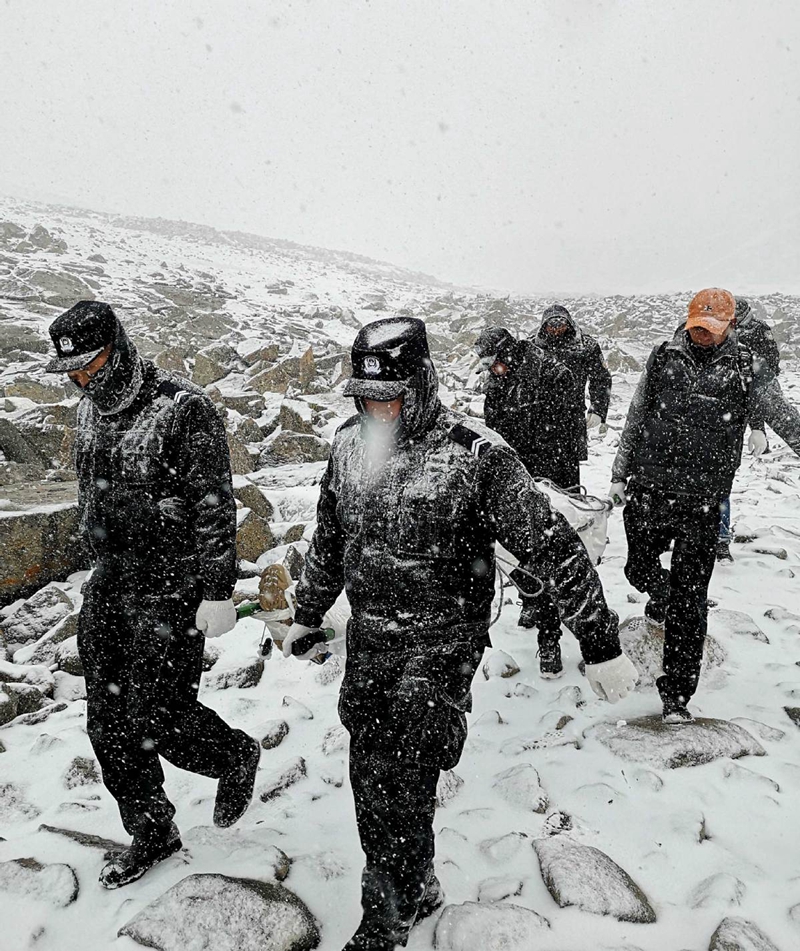Officers carry the body of a tourist downhill through a heavy snowstorm in Darchen, Tibet autonomous region, in June. Provided To China Daily
Patrolmen at a mountain police station are adept at dealing with a large influx of religious visitors and general tourists. Wang Xiaoyu reports from Ngari prefecture, Tibet autonomous region.
Editor's note: This is the fourth in a series of stories about China's border patrol guards, focusing on the challenges they face and their work to keep the country safe, prevent trafficking of drugs and people, and maintain friendly relations with their counterparts in neighboring countries.
A white public security bureau van roared past a meters-wide pothole and continued its journey along a jagged dirt track.
The next stop for the five officers inside was a campsite for trekkers and pilgrims who are tackling the 56-kilometer trail around Gang Rinpoche, aka Mount Kailash, in the Tibet autonomous region.
Holding onto a strap hanging from the roof, police officer Guo Fengfeng appeared unruffled by the vehicle's erratic progress, and he was undaunted by the thin air along the route he and his colleagues patrol at least twice a week.
At an altitude of about 5,000 meters near the southwestern tip of Ngari, the oxygen level is just 40 percent that at sea level.
After arriving in the prefecture in 2016, it took time for the native of the northwestern province of Gansu to adapt to the rigors of high-altitude life.
"It took months to become accustomed to the thin air," the 26-year-old said. "I remember that when I first arrived, my head reeled so badly at night that I had to get out of bed and kill sleepless hours by looking at the stars."
He is one of 28 officers at the Darchen Border Control Police Station at the foot of the mountain who are responsible for patrolling the pilgrims' path. In addition to routine duties such as maintaining order and resolving neighborhood disputes, the officers undertake rescue missions when necessary.
Unlike Guo, most people from the Tibetan ethnic group he visited during the early October patrol are physically capable of working in the alpine environment.
That's why dozens of them migrate from nearby villages to the higher terrain from May to October, the peak travel season, setting up lodges and providing accommodations for visitors.
Dangers still abound, though. "The weather could turn nasty in the coming weeks. It won't be long before the rugged earth we just drove past is covered by deep snow and completely devoid of any vehicles," Guo said.
"We'll give people a heads-up that the benign weather will soon end and it's about time to wrap things up and move downhill," he added, referring to settlements at least 200 meters lower down the mountain, where the houses are sturdier and safer than the dwellings at higher altitude.
The risks the tourists face are intimidating. Fang Junjie, the station chief, said most visitors aim to complete a circuit of the peak. Some are well-prepared groups of pilgrims or professional hikers, while others are less experienced and even oblivious to the hazards in the thin air.
"An otherwise harmless mistake could spiral out of control due to the harsh environment," he said.
"In addition to altitude-related conditions, we have received reports of incidents triggered by people tripping over or taking the wrong direction at crossroads."






7740f3b5-9ecb-438e-9052-76cb2d4bb671.jpg)

